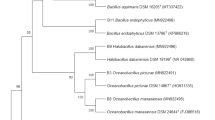Abstract
228 strains of soil and rhizosphere pseudomonads isolated in different geographic zones were screened, with the use of two tester systems, for the capacity to produce N-acyl-homoserine lactones (AHLs), which are autoinducers involved in quorum-sensing (QS) regulation. AHL production was found in 11.4% of the strains investigated. In five Pseudomonas chlororaphis strains shown to be active AHL producers and chosen for further study, PCR identified two QS systems that involved the phzI, phzR, csaI, and csaR genes; this finding suggests the conservative nature of these regulation systems in P. chloroaphis. Strain P. chlororaphis 449, chosen as a model object and studied in greater detail, produced three AHL species including N-butanoyl-homoserine lactone and N-hexanoyl-homoserine lactone. This strain produced three types of phenazine antibiotics, as well as siderophores and cyanide; it also exhibited antagonistic properties toward a wide spectrum of phytopathogenic fungi. The phzI and csaI genes, coding for synthases of AHLs of two types, were cloned and sequenced; mutants with knocked-out phzI and csaI genes were obtained. With the use of transposon mutagenesis and the gene substitution method, mutations were obtained in the global expression regulator genes gacS, coding for the GacA-GacS regulation system kinase, and rpoS, coding for the sigma S subunit of RNA polymerase. The effect of these mutations on the AHL synthesis and on the regulation of various metabolic processes in P. chlororaphis was studied.
Similar content being viewed by others
References
Fuqua, W.C., Winans, S.C., and Greenberg, E.P., Census and Consensus in Bacterial Ecosystems: The LuxR-LuxI Family of Quorum-Sensing Transcriptional Regulators, Annu. Rev. Microbiol, 1996, vol. 50, pp. 727–751.
Miller, M.B. and Bassler, B.L., Quorum Sensing in Bacteria, Annu. Rev. Microbiol., 2001, vol. 55, pp. 165–199.
Zavilgelsky, G.B. and Manukhov, I.V., Quorum Sensing, or How Bacteria “Talk” to Each Other, Mol. Biol., 2001, vol. 35, pp. 268–277 [Mol. Biol. (Engl. Transl.), vol. 35, pp. 224–232].
Taga, M.E. and Bassler, B.L., Chemical Communication among Bacteria, Proc. Natl. Acad. Sci. USA, 2003, vol. 100, suppl. 2, pp. 14549–14554.
Gintsburg, A.L., Il’ina, T.S., and Romanova, Yu.M., “Quorum Sensing,” or Social Behavior of Bacteria, Zh. Mikrobiol. Epidemiol. Immunobiol., 2003, no. 5, pp. 86–93.
March, J.C. and Bentley, W.E., Quorum Sensing and Bacterial Cross-Talk in Biotechnology, Curr. Opin. Biotechnol., 2004, vol. 15, pp. 495–502.
Waters, C. and Bassler, B., Quorum Sensing: Cell-to-Cell Communication in Bacteria, Annu. Rev. Cell Dev. Biol., 2005, vol. 21, pp. 319–346.
Khmel, I.A. and Metlitskaya, A.Z., Quorum Sensing Regulation of Gene Expression: A Promising Target for Drugs against Bacterial Pathogenicity, Mol. Biol., 2006, vol. 40, no. 2, pp. 195–210 [Mol. Biol. (Engl. Transl.), vol. 40, no. 2, pp. 169–182].
Khmel, I.A., Quorum-Sensing Regulation of Gene Expression: Fundamental and Applied Aspects and the Role in Bacterial Communication, Mikrobiologiya, 2006, vol. 75, no. 4 [Microbiology (Engl. Transl.), vol. 75, no. 4.
McClean, K.H., Winson, M.K., Fish, L., Taylor, A., Chhabra, S.R., Camara, M., Daykin, M., Lamb, J.H., Swift, S., Bycroft, B.W., Stewart, G.S.A.B., and Williams, P., Quorum Sensing in Chromobacterium violaceum: Exploitation of Violacein Production and Inhibition for the Detection of N-Acylhomoserine Lactones, Microbiology (UK), 1997, vol. 143, pp. 3703–3711.
Shaw, P.D., Ping, G., Daly, S.L., Cha, C., Cronan, J.E., Jr., Rinehart, K.L., and Farrand, S.K., Detecting and Characterizing N-Acyl-Homoserine Lactone Signal Molecules by Thin-Layer Chromatography, Proc. Natl. Acad. Sci. USA, 1997, vol. 94, pp. 6036–6041.
Rice, S.A., Kjelleberg, S., Givskov, M., Boer, W., and Chernin, L., Detection of Bacterial Homoserine Lactone Quorum Sensing Signals, Molecular Microbial Ecology Manual, 2nd ed. Kowalchuk, G.A. et al., Eds., Dordrecht: Kluwer Academic, 2004, Chapter 8.04, pp. 1629–1649.
Veselova, M., Kholmeckaya, M., Klein, S., Voronina, E., Lipasova, V., Metlitskaya, A., Mayatskaya, A., Lobanok, E., Khmel, I., and Chernin, L., Production of N-Acylhomoserine Lactone Signal Molecules by Gram-Negative Soil-Borne and Plant-Associated Bacteria, Folia Microbiol., 2003, vol. 48, pp. 794–798.
Zhang, Z. and Pierson III, L.S., A Second Quorum Sensing System Regulates Cell Surface Properties but Not Phenazine Antibiotic Production in Pseudomonas aureofaciens, Appl. Environ. Microbiol., 2001, vol. 67, pp. 4305–4315.
Hoang, T.T., Karkhoff-Schweizer, R.R., Kutchma, A.J., and Schweizer, H.P., A Broad-Host-Range Flp-FRT Recombination System for Site-Specific Excision of Chromosomally-Located DNA Sequences: Application for Isolation of Unmarked Pseudomonas aeruginosa Mutants, Gene, 1998, vol. 212, pp. 77–86.
Hengge-Aronis, R., Signal Transduction and Regulatory Mechanisms Involved in Control of the σS (RpoS) Subunit of RNA Polymerase, Microbiol. Mol. Biol. Rev., 2002, vol. 66, pp. 373–395.
Khmel, I.A., Regulation of Expression of Bacterial Genes in the Absence of Active Cell Growth, Genetika, 2005, vol. 41, no. 9, pp. 1183–1202 [Russ. J. Genet. (Engl. Transl.), vol. 41, no. 9, pp. 968–984].
de Lorenzo, V. and Timmis, K.N., Analysis and Construction of Stable Phenotypes in Gram-Negative Bacteria with Tn5-and Tn10-Derived Minitransposons, Methods Enzymol., 1994, vol. 235, pp. 386–405.
Chancey, S.T., Wood, D.W., and Pierson, L.S., Two-Component Transcriptional Regulation of N-Acyl-Homoserine Lactone Production in Pseudomonas aureofaciens, Appl. Environ. Microbiol., 1999, vol. 65, pp. 2294–2299.
Author information
Authors and Affiliations
Additional information
Original Russian Text © M.A. Veselova, V.A. Lipasova, O.B. Astaurova, E.E. Atamova, M.A. Protsenko, N.L. Buza, A.Z. Metlitskaya, N.N. Danilova, L.S. Chermin, I.A. Khmel, 2006, published in Mikrobiologiya, 2006, Vol. 75, No. 4, pp. 465–467.
Rights and permissions
About this article
Cite this article
Veselova, M.A., Lipasova, V.A., Astaurova, O.B. et al. Quorum-sensing regulation in soil pseudomonads. Microbiology 75, 398–400 (2006). https://doi.org/10.1134/S0026261706040059
Received:
Issue Date:
DOI: https://doi.org/10.1134/S0026261706040059




